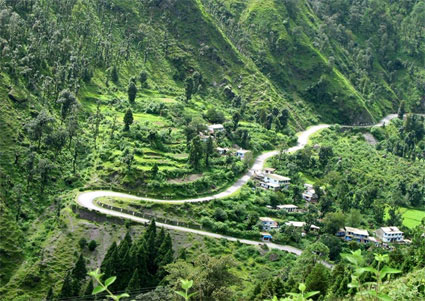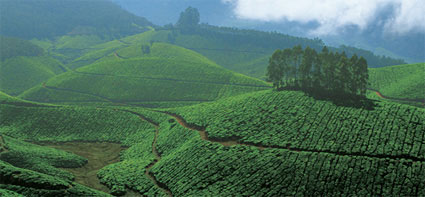Darjeeling and Assam teas are world-famous, but in India there is a strong contender to them from the Nilgiris in the South. You may be better acquainted with the Nilgiris through its highly-popular hill-station of Ooty, formally, Udhagamandalam. In this articleBlue Mountains full of greeneryStopover at CoonoorOoty- Queen of hill-stationsVisit to tea estates Blue Mountains full of greenery The Nilgiris in Tamil Nadu is the second largest mountain range in India after the Himalayas. Nilgiris or Blue Mountains, thus-called because of the blue haze that the vegetation bears, are a naturalists delight. Everywhere you are greeted with towering eucalyptus and pines, colourful rhododendrons, and lush green tea gardens. Nilgiris is also home to the rich shola forests with its unique flora and fauna. Bird species such as the Nilgiri verditer flycatcher, thrushes and skylarks are endemic to the region, just as the Nilgiri Tahr or mountain goat is. It calls for a trek or a long walk to unravel the place and discover its rhythm and there are plenty of trekking routes to follow. Equally beautiful, though lesser-known are two other hill-stations, Coonoor and Kotagiri. Coonoor lies on the Mettupalayam-Ooty route (Mettupalayam is a sister city of Coimbatore, 30 kms off Ooty), which also has a quaint railway - the Blue Mountain Railway. Kotagiri is further ahead of Ooty. Stopover at Coonoor There is no dearth of accommodation in Coonoor and Ooty as these places are bustling with guest houses and cottages; you just need to make your pick. But Upper Coonoor is a better option as it has some lovely tourist homes, snuggled in scenic valleys. Elsewhere in Coonoor and in Ooty, commercialisation has robbed many places of its natural beauty. There are many number of picturesque picnic spots, especially by the many waterfalls that dot the hilly landscape. Coonoor is a small place so you can easily take in most of its tourist hotspots like Sims Park, Lambs Rock and Laws Falls. Sims Park is a beautiful botanical garden with hundreds of plant species including tree ferns and magnolia. It has a hundred varieties of roses. A visit here is an education in itself while being a completely relaxing experience. Ooty- Queen of hill-stations Conoors climate is a little milder than Ooty. But the nights are colder even in summer and light woollens are a must. Winters, of course, can get pretty cold with temperatures falling below zero degrees. Ooty, the Queen of hill-stations still retains its colonial charm in pockets. These hills were and are home to the Toda tribes, who live in relative isolation far from the madding crowds. The Toda embroidery and jewellery is a big draw with the tourists. Ooty has a lot of old clubs like the Gymkhana Club and Ooty Club with an emphasis on golf and horse-riding. The Nilgiri Library, which is a treasure-house of information on the area and its history, is an inviting place where you can spend hours together, browsing happily. The Botanical Gardens maintained by the Horticulture Department of the Tamil Nadu Government at Ooty is a great showcase of flowers - both exotic and indigenous. A flower and vegetable show is held every summer, in May, which is not to be missed for the world. The Ooty lake is picturesque, but quite touristy. It has a boathouse with rowboats and motorboats for delightful joyrides. But if you want to avoid the crowds, you can skip this one, and take in the Pykara lake, nearly 20 kms away, instead. Visit to tea estates Wherever you go in Coonoor and Ooty, you cannot escape the tea bushes of the any number of tea gardens that dot the hill-sides. You must make it a point to visit some tea estates to learn about tea-picking and processing. You can even do a bit of tea-tasting on some estates who allow visitors. Try booking yourself at the Wallwood Garden in Coonoor, which is a Raj-style resort amidst a tea plantation. January-February is the time for the tea and tourism festival, when Coonoor is visited by connoisseurs and buyers the world over. Kotagiri, higher up, ahead of Ooty is a relatively quieter hill-station and definitely worth a visit. The view of the valley down below from Kodanad Viewpoint where you can see as far as Mysore and Coimbatore on a clear day is truly breath-taking and awe-inspiring. If you have a few more days on hand, you may want to visit the Mudumalai Wildlife Sanctuary on Ooty-Mysore route or the Mukurthi National Park.
Darjeeling and Assam teas are world-famous, but in India there is a strong contender to them from the Nilgiris in the South. You may be better acquainted with the Nilgiris through its highly-popular hill-station of Ooty, formally, Udhagamandalam.
Blue Mountains full of greenery
The Nilgiris in Tamil Nadu is the second largest mountain range in India after the Himalayas. Nilgiris or Blue Mountains, thus-called because of the blue haze that the vegetation bears, are a naturalists' delight. Everywhere you are greeted with towering eucalyptus and pines, colourful rhododendrons, and lush green tea gardens. Nilgiris is also home to the rich
shola forests with its unique flora and fauna. Bird species such as the Nilgiri verditer flycatcher, thrushes and skylarks are endemic to the region, just as the Nilgiri Tahr or mountain goat is. It calls for a trek or a long walk to unravel the place and discover its rhythm and there are plenty of trekking routes to follow.
Equally beautiful, though lesser-known are two other hill-stations, Coonoor and Kotagiri. Coonoor lies on the Mettupalayam-Ooty route (Mettupalayam is a sister city of Coimbatore, 30 kms off Ooty), which also has a quaint railway - the Blue Mountain Railway. Kotagiri is further ahead of Ooty.
Stopover at Coonoor
There is no dearth of accommodation in Coonoor and Ooty as these places are bustling with guest houses and cottages; you just need to make your pick. But Upper Coonoor is a better option as it has some lovely tourist homes, snuggled in scenic valleys. Elsewhere in Coonoor and in Ooty, commercialisation has robbed many places of its natural beauty.
There are many number of picturesque picnic spots, especially by the many waterfalls that dot the hilly landscape. Coonoor is a small place so you can easily take in most of its tourist hotspots like Sim's Park, Lamb's Rock and Law's Falls. Sim's Park is a beautiful botanical garden with hundreds of plant species including tree ferns and magnolia. It has a hundred varieties of roses. A visit here is an education in itself while being a completely relaxing experience.
Ooty- Queen of hill-stations
Conoor's climate is a little milder than Ooty. But the nights are colder even in summer and light woollens are a must. Winters, of course, can get pretty cold with temperatures falling below zero degrees.
Ooty, the Queen of hill-stations still retains its colonial charm in pockets. These hills were and are home to the Toda tribes, who live in relative isolation far from the madding crowds. The Toda embroidery and jewellery is a big draw with the tourists. Ooty has a lot of old clubs like the Gymkhana Club and Ooty Club with an emphasis on golf and horse-riding. The Nilgiri Library, which is a treasure-house of information on the area and its history, is an inviting place where you can spend hours together, browsing happily.
The Botanical Gardens maintained by the Horticulture Department of the Tamil Nadu Government at Ooty is a great showcase of flowers - both exotic and indigenous. A flower and vegetable show is held every summer, in May, which is not to be missed for the world. The Ooty lake is picturesque, but quite touristy. It has a boathouse with rowboats and motorboats for delightful joyrides. But if you want to avoid the crowds, you can skip this one, and take in the Pykara lake, nearly 20 kms away, instead.
Visit to tea estates
Wherever you go in Coonoor and Ooty, you cannot escape the tea bushes of the any number of tea gardens that dot the hill-sides. You must make it a point to visit some tea estates to learn about tea-picking and processing. You can even do a bit of tea-tasting on some estates who allow visitors. Try booking yourself at the Wallwood Garden in Coonoor, which is a Raj-style resort amidst a tea plantation. January-February is the time for the tea and tourism festival, when Coonoor is visited by connoisseurs and buyers the world over.
Kotagiri, higher up, ahead of Ooty is a relatively quieter hill-station and definitely worth a visit. The view of the valley down below from Kodanad Viewpoint where you can see as far as Mysore and Coimbatore on a clear day is truly breath-taking and awe-inspiring. If you have a few more days on hand, you may want to visit the Mudumalai Wildlife Sanctuary on Ooty-Mysore route or the Mukurthi National Park.































